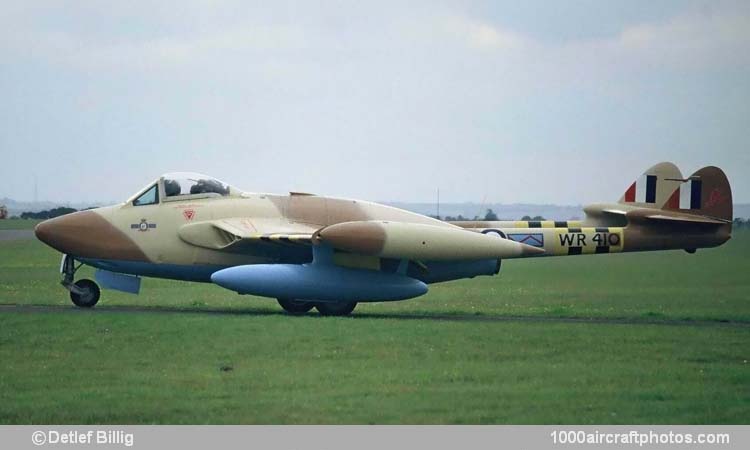05/31/2011. Remarks by Johan Visschedijk: "Development of an improved version of the D.H.100 Vampire. with a thinner wing and uprated engine, began in 1948 under the designation Vampire 8 and proceeded to Specification F.15/49 as the D.H.112, subsequently named Venom.
With the same configuration as the Vampire, the Venom was powered by the 4,850 lb (2,200 kg) st de Havilland Ghost 103 jet engine, had slight quarter-chord sweepback on the wing and carried extra fuel in wing tip tanks. The armament, as in the Vampire, comprised four 0.787 in (20 mm) cannon, with strong points for up to 2,000 lb (907 kg) of bombs or rockets. The prototype D.H.112 first flew on September 2, 1949, and the first of 375 Venom FB.Mk.1s for the RAF flew in June 1951.
Service use began in August 1952, and later production aircraft were fitted with Martin-Baker ejection seats. The Venom FB.Mk.4 was similar but had revised, flat-topped, fin-and-rudder design, powered ailerons, the 5,150 lb (2,336 kg) st Ghost 105 engine and provision for underwing drop tanks. The prototype (a converted Mk.1) flew on December 29, 1953, and delivery of 150 for the RAF began in May 1954. Venezuela purchased 22 Venom FB.Mk.4s in 1955-1956, and a similar export version was designated FB.Mk.50, two being supplied to Italy and 15 to Iraq.
In Switzerland, a consortium formed by EFW (Eidgenössisches Flugzeugwerk, Federal Aircraft Factory) at Emmen, FFA (Flugzeugwerke Altenrhein) at Altenrhein, and Pilatus Flugzeugwerke at Stans, built 100 Venom FB.Mk.1s and 150 FB.Mk.4s (sometimes referred to as FB.Mk.51s FB.Mk.54s), with the serials J-1501 to J-1650 and J-1701 to J-1800 respectively.
J-1790 was delivered on January 15, 1958, and served 26 years with the Swiss AF, it was struck off charge on July 5, 1984. Eight days later it was registered in the UK to Alexander 'Sandy' Topen of Bushey Hertfordshire as G-BLKA and marked as the RAF FB.Mk.4 WR410, it was flown out of Cranfield in the airshow circuit for many years. On November 1, 1996, the aircraft was acquired by the de Havilland Aviation Ltd. at St. Mary Hill near Bridgend, South Wales. Its flying life ended in 2000 and the aircraft was deregistered on October 13.
Presently the aircraft is at the de Havilland Aircraft Heritage Centre, London Colney."
